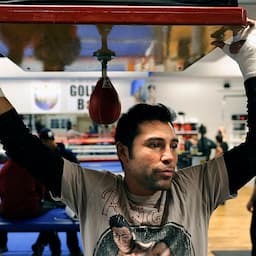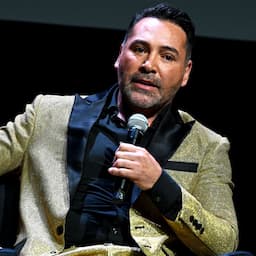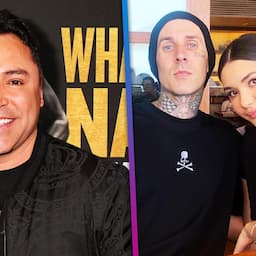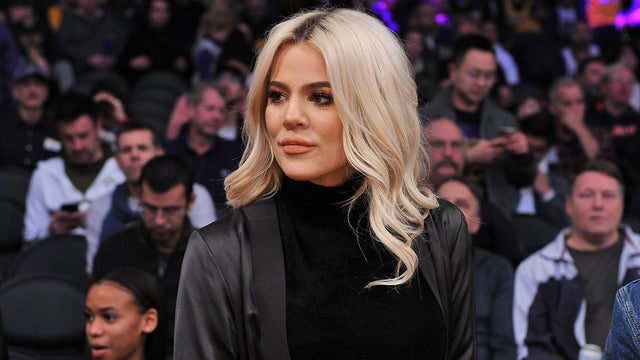De La Hoya opens up to ET about the infamous 2007 photos of him dressed in women's clothing.
Oscar De La Hoya is done running from his haunted past. He is done hiding behind the "golden" facade and he is done lying. No longer feeling pressured to maintain what is left of his once unblemished "Golden Boy" image, De La Hoya feels "liberated," a byproduct of unshackling himself from a self-made prison rooted in -- by his own admission -- lies he peddled for years.
Decades, actually.
Now calling himself "an open book," the 1992 Olympic gold medalist is finally ready to talk -- without discomfort or an ounce of awkwardness -- about some of his darkest moments. Take the photos of him dressed in lingerie, for example. The world first got a glance of the headline-making photos -- with De La Hoya wearing fishnet body stockings, a wig, tutu, heels, bra and tight, pink underwear -- after they were leaked to a New York tabloid in 2007. But it was actually not the first time the boxing great found himself in such compromising position.
He had been there before -- as a little boy -- at the behest of his late mother, Cecilia Gonzalez De La Hoya. Speaking to ET ahead of the premiere of his two-part HBO documentary aptly dubbed, The Golden Boy, De La Hoya recalls his mother dressing him up in girls' clothing.
"[I was] five or six years old, maybe," the 50-year-old tells ET. "Yeah, I do remember it ..."
It is the second extensive interview De La Hoya grants to ET in less than a week this month. Nothing is off limits.
With that in mind, the Hall of Fame boxer is asked if there is any truth to a claim made in the documentary by former Russian exotic dancer Milana Dravnel -- the woman photographed with De La Hoya in those 2007 photos -- that he once told her during one of their countless drug- and booze-fueled encounters that his mother -- before he was born -- wanted a little girl and that she would dress him up and they would sing and play.
De La Hoya does not offer a rebuttal to the bombshell claim in the documentary. So, when asked if Dravnel’s claim rings a bell, the 10-time world boxing champion tells ET he absolutely recalls that "odd" part of his fractured relationship with his mother.
"Yeah, I do remember it ... I do remember it ... I do remember it," says De La Hoya. "Yeah. I remember a couple of times -- just to kind of, like, feel her and feel her love -- I would open up her drawer and smell her undergarments [De La Hoya bunches up his hands, brings them close to his nose]. Just to feel close to her, to my mom, you know? Because she never told me she loved me. So, that was a way for me to just feel her love, you know? So, yeah. There is truth to that."
De La Hoya has been open about the physical abuse he endured at the hands of his mother, who died from stage 4 breast cancer in October 1990, two years shy of De La Hoya capturing gold at the Olympic Games in Barcelona.
After winning the gold medal, De La Hoya became an instant celebrity. He got his first taste of the limelight after arriving from Barcelona and landing at LAX, where hordes of fans and local media awaited his arrival to give him a champion's welcome. Pandemonium ensued when a caravan of cars followed him and his family back to their home in East Los Angeles. A few days after arriving from Barcelona, De La Hoya mustered up the courage to visit his mother's grave. He wanted to talk to her, but he wanted to do so without cameras following his every step. The local media obliged, he says, and off he went to visit his mother. He was 19 at the time.
"I finally got to the cemetery. By myself. The first words, literally -- I mean, I balled up and cried -- but the first words were, 'What the f**k? Why did you f**king do this to me?'" De La Hoya recalls. "I was angry. I blew up. 'I f**king hate you.'"
This hatred directed at his mother did not reconcile with the love and adulation he showered her in dozens -- if not hundreds -- of interviews after she died and in the run-up to Barcelona, and beyond. After winning the gold medal, whenever he evoked her memory, De La Hoya had a tendency to revere her with sainthood-like devotion. But unbeknownst to the world, his reality was so far removed from the doting mother-son relationship narrative he pushed for years after she died.
Like when De La Hoya said Cecilia told him her dying wish was for him to win the Olympic gold medal. It was a sweet story that tugged at the heartstrings. His heart wrenching story lent itself to powerful headlines -- "To Mom, In Heaven: De La Hoya Boxes to Gold," read one national newspaper's headline.
It was undoubtedly a sweet and inspiring story.
But it was also a lie.
He comes clean about it in the documentary. When asked if he takes ownership of creating that false narrative, De La Hoya tells ET that he does.
"I do, because ... when I was getting back from the Olympics, you can imagine. Look, I'm a kid from East L.A., who grew up in humble beginnings," he says. "I was a quiet kid. I was very shy. You [could] barely get a few words out of my mouth. That's how shy I was. So, everything was overwhelming."
"OK, I've accepted that [the narrative], it's now part of me. So, when they're starting to ask questions, 'How does it feel doing it for your mother?' in a way you're now being conditioned. 'OK, let's use that as the narrative. Let's run with that,'" he continues. "And not even thinking [to] myself, 'OK, that sounds great. This is going to be great for my career.' No, it was like, 'OK, that sounds good, actually.' I never thought, 'You know, I can use this to get popular. People will love me.'"
De La Hoya desperately wanted to feel a connection with his late mother, which explains his short-lived Latin pop singing career. He has said in the past that he launched the singing career because it was something he wanted for himself. But, in a "twisted" way, De La Hoya now admits music was another way to connect with his mother.
He also desperately sought her approval.
"I'm gonna do an album for her. That was the whole motivation, to make her proud," he says. "To continue to make her proud. Think about this -- I have to make her proud even though she was abusive to me. How twisted in the head I am. It's crazy."
De La Hoya, whose self-titled album earned a GRAMMY nomination for Best Latin Pop Album (he lost to Shakira's MTV Unplugged in 2001), says the "twisted" memory is something he would like to explore one day with a therapist.
"To tell me exactly what I was thinking," he continues. "What was the thought behind that? Because I didn't do it for myself. I did it for her. I took time off from my boxing career, a year off -- in my prime! -- to do music. But I felt I had to do it for her. I still had to do stuff for her. The gold medal was not enough. I still had to make her happy by doing what she loved doing. It's pretty, psychologically, it's pretty incredible how I survived all that."
In hindsight, it’s incredible he survived at all:
- De La Hoya lived with his father, Joel Sr., and siblings, Joel Jr. and Ceci -- the only children the former boxer says never endured their mother's physical abuse -- in a humble East Los Angeles apartment complex located across the street from what he describes as "a crack house." The gang leader of that "crack house" once assured De La Hoya he was "protected" because they sensed the boxing prowess he possessed would be his meal ticket to stardom.
- He lost his virginity at 13 when he was raped by a woman over 35. It's a traumatizing experience he rarely ever opens up about, only to say that the experience altered his upbringing and how he conducted himself around others.
"You put yourself in a shell. It makes you more timid," he says. "You know, being out with people I was very -- not scared -- but reserved."
- Once, in high school, while walking to a girlfriend's house, De La Hoya got mugged by masked men who pointed half a dozen guns at his head. He gave up his wallet, only to find it later at home, where his father told him his "friends" dropped it off. The gunmen turned out to be members of the gang whose leader had previously told him he would never find himself in their crosshairs. It was dark, and the gang members had no idea they were mugging De La Hoya, until they saw his picture I.D. in his wallet.
- He had his first beer at a family party when he was seven or eight years old. His drinking consumption ultimately intensified and it led him down a dark path where he soon found cocaine, all of which resulted in several stints in rehab. His life came so close to coming to a screeching halt just a few years after turning pro, while driving drunk and getting behind the wheel of his Ferrari.
"I remember drinking and then driving the 10 freeway hitting the 710 freeway in L.A. and going 170 [miles per hour], and literally not caring. Not caring what happens," he recalls. "You can imagine, at the time when I was 22, 23. I already was overwhelmed. I couldn't take it. I already was thinking, 'My gosh, this is too much for me. This lifestyle, I cannot take this.' And I do have to say I was probably depressed nine times over throughout my life, and not even knowing it."
"Luckily I had boxing, where I can get inside the ring and beat the crap out of somebody, and you feel relieved," he continues. "And that was my therapy, getting in the ring and beating the crap out of somebody. So, thank God for boxing 'cause at an early age -- the fame, the money -- everything came at me so fast. And I didn't know how to deal with it."
Something else he didn't know how to deal with? The lingerie photos that were leaked in 2007 and splashed across the front page of the New York Post with the headline reading, "Beauty vs. kinky beast." It is hard to fathom how De La Hoya would survive a scandal of this magnitude today, but he averted disaster at the time thanks to a hired forensic expert who claimed at the time that the lingerie photos were digitally altered. Four years after he was engulfed in the scandal, De La Hoya admitted -- calmly, mind you -- for the first time in a 2011 interview with Teresa Rodriguez on the Univision newsmagazine show, Aquí y Ahora, that the photos were authentic. At that point, he said he was at peace and ready to tell the truth. But make no mistake, De La Hoya went to incredible lengths to keep the photos from seeing the light of day.
He counted on his handlers to deal with the threat of the leak and the ensuing fallout, a lot of which is covered in the documentary. But the wheeling and dealing that went into brokering a deal to prevent the photos from leaking to the media (they leaked the next day anyway) didn't make the documentary.
De La Hoya tells ET that the negotiating responsibility fell to a former executive at his boxing promotional firm, Golden Boy Promotions.
"He told me this story about the Russian mob and this and that and [how] we gotta pay millions of dollars," De La Hoya says. "I'm like, 'Yeah, well, just make it go away. It's gonna ruin my image. It's gonna ruin who the Golden Boy is and people are gonna hate me. Just make it go away.'"
De La Hoya says his handlers immediately hopped on a flight to New York City, where they met the other negotiating party at, of all places, a rooftop pool.
"That's the story that they told me, is that my lawyer at the time had to jump into a rooftop pool in New York with one of the Russian mobsters to make sure that they didn’t have wires connected to their body," he says. "And sure enough, apparently they paid all this money, but yet the photos still leaked. So, I never really investigated all that. I never knew exactly what really happened. The documentary sheds a little bit of light on it, but it's all confusing to me."
Dravnel, the former Russian exotic dancer who was blamed for leaking the photos -- she sued De La Hoya after claiming she was tricked into agreeing the photos were digitally altered and the parties settled out of court for an undisclosed sum -- is prominently featured in The Golden Boy. Producers tracked her down in the remote but picturesque Indigenous town of Lake Atitlán, Guatemala, where she claimed De La Hoya told her he sang and danced with his mother when she would dress him in girls' clothing.
After admitting to ET that Dravnel's claim was, in fact, true, it is clear De La Hoya still has not yet come to terms with the "odd" experience. When asked if his mom's eyes lit up and whether he felt her love in those precise moments, De La Hoya's bewilderment is evident.
"I don't know. It was odd. It was odd," De La Hoya says. "It was obviously not normal, you know? Yeah, it was just odd. It was odd. I was a kid, you know?"
De La Hoya says he did not set out to participate in a tell-all documentary to exonerate himself from a horrid past -- being an absentee father to his six children, the womanizing, and accusations of rape and sexual assault. These are just some of the jarring topics addressed in the documentary. De La Hoya was accused of rape in a 1998 civil lawsuit and the sides struck a settlement out of court in 2001. He was accused of rape again in December 1999, but no criminal charges were filed in that case. He was sued again in 2022 by a woman alleging De La Hoya sexually assaulted her during two alleged incidents in 2020. He's denied the accusations.
"Look, people who know me, [know] I'm not a bad guy. I'm just not. I'm a [10]-time world champion [in] six divisions, but I couldn't hurt a fly," De La Hoya says. "It’s just not me. It's just not. There's this sensitivity that I'm actually very proud of ... but the bottom line is I didn't do this to clear my name ... I did this documentary, literally, to free myself from my own past. To free myself from what I lived, the lie of what the public built, and that's the Golden Boy."
De La Hoya acknowledges that "the Golden Boy" image is "tarnished." Deep down, amid all the glory and celebration, he says he used to feel "empty," "hurt" and "in pain." That's no longer the case.
"[The Golden Boy] was not what the people thought. And yet, the Golden Boy machine was just so overwhelming -- my image, the smiling. I couldn't do anything wrong in the public," he says. "I was just tired of all that. I was tired of living a lie."
He adds, "Look, I'm an open book now. I'm free. At 50 years old, I feel like I've been given a second chance."
The Golden Boy premieres Monday, July 24, with part two airing Tuesday, July 25 at 9 p.m. ET/PT on HBO. Both episodes will be available to stream on Max beginning Monday, July 24 at 9 p.m. ET/PT.
RELATED CONTENT:



